Category: QuickStats
QuickStats: Sepsis-Related Death Rates Among Persons Aged ≥65 Years, by Age Group and Sex — National Vital Statistics System, United States, 2021
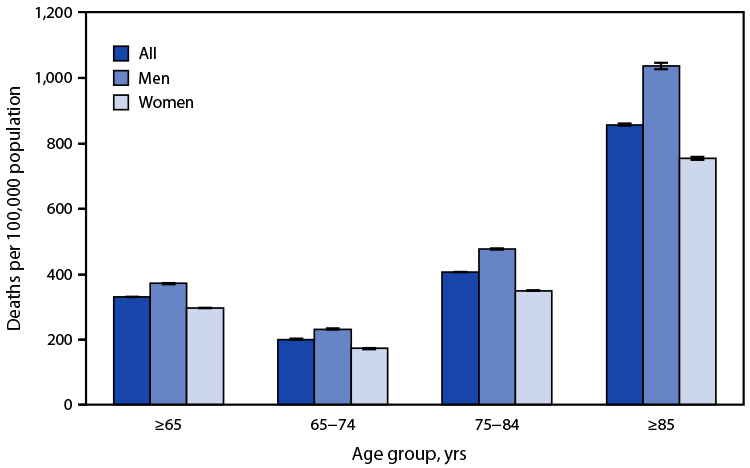
In 2021, the sepsis-related death rate among persons aged ≥65 years was 330.9 deaths per 100,000 population; the rate among men (371.7) was higher than that among women (297.4). Sepsis-related death rates among men were higher than those among women in each age group: 232.7 versus 173.0 (65–74 years), 477.3 versus 349.8 (75–84 years), and Read More >
Posted on byQuickStats: Number of Deaths Resulting from Being Bitten or Struck by a Dog, by Sex — National Vital Statistics System, United States, 2011–2021
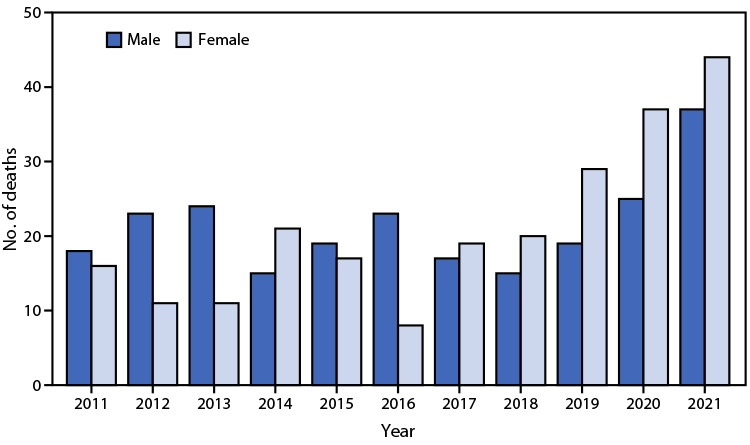
During 2011–2021, a total of 468 deaths from being bitten or struck by a dog occurred (average = 43 deaths per year). The annual number of deaths ranged from 31 (2016) to 81 (2021). During 2011–2016, more deaths occurred among males than among females during most years; however, during 2017–2021, more deaths occurred among females Read More >
Posted on byQuickStats: Age-Adjusted Rates of Death Involving Exposure to Excessive Heat Among States with the Highest Numbers of Deaths — National Vital Statistics System, United States, 2021
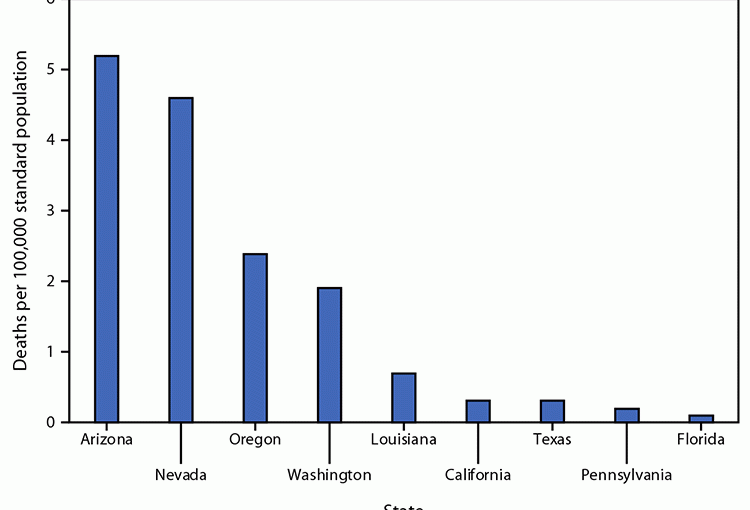
The 2021 age-adjusted heat-related death rate for the United States was 0.4 deaths per 100,000 population. A total of 1,600 deaths were reported, and nine states accounted for >75% (1,226) of those deaths. Arizona recorded 426 deaths and had the highest rate (5.2 per 100,000), followed by Nevada (4.6), Oregon (2.4), Washington (1.9), and Louisiana Read More >
Posted on byQuickStats: Unintentional Drowning Death Rates of Children and Adolescents Aged 0–17 Years, by Sex and Age Group — United States, 2020–2021
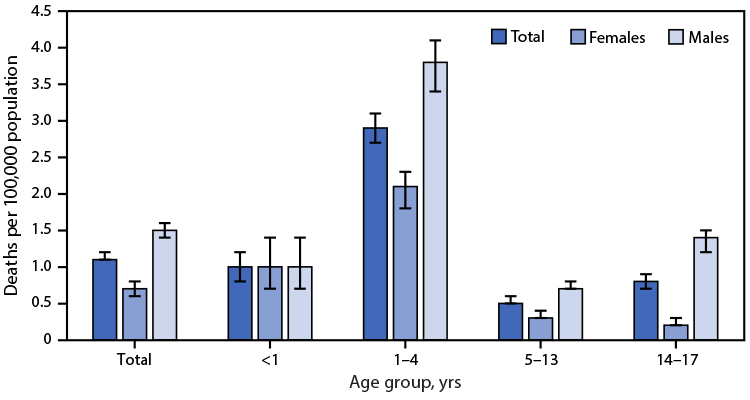
During 2020–2021, the unintentional drowning death rate was 1.1 deaths per 100,000 population among children and adolescents aged 0–17 years. Rates were higher among males (1.5) than females (0.7). Among children aged <1 year, boys and girls had similar unintentional drowning death rates (1.0), whereas rates were higher for males than for females among those Read More >
Posted on byQuickStats: Percentage of Children and Adolescents Aged ≤17 Years Who Had Ever Received a Diagnosis of Concussion or Brain Injury, by Sex and Age Group — National Health Interview Survey, United States, 2022

In 2022, 2.3 million (3.2%) children and adolescents aged ≤17 years had ever received a diagnosis of a concussion or brain injury. Diagnosis of a concussion or brain injury increased with age, from 1.0% among those aged 0–5 years to 2.3% among those aged 6–11 years, and 5.9% among those aged 12–17 years. Percentages were Read More >
Posted on byQuickStats: Percentage of Adults Aged ≥18 Years who Received an Influenza Vaccination in the Past 12 Months, by Race and Ethnicity and Family Income — National Health Interview Survey, United States, 2021

In 2021, non-Hispanic Asian (Asian) adults aged ≥18 years were the most likely to receive an influenza vaccination in the past 12 months (57.1%) followed by non-Hispanic White (White) (53.3%) adults; Hispanic or Latino (Hispanic) and non-Hispanic Black or African American (Black) adults were the least likely to receive an influenza vaccination (37.7% and 37.9%, Read More >
Posted on byQuickStats: Percentage of Children and Adolescents Aged ≤17 Years Who Have Experienced a Specified Stressful Life Event, by Type of Event and Family Income — National Health Interview Survey, United States, 2021
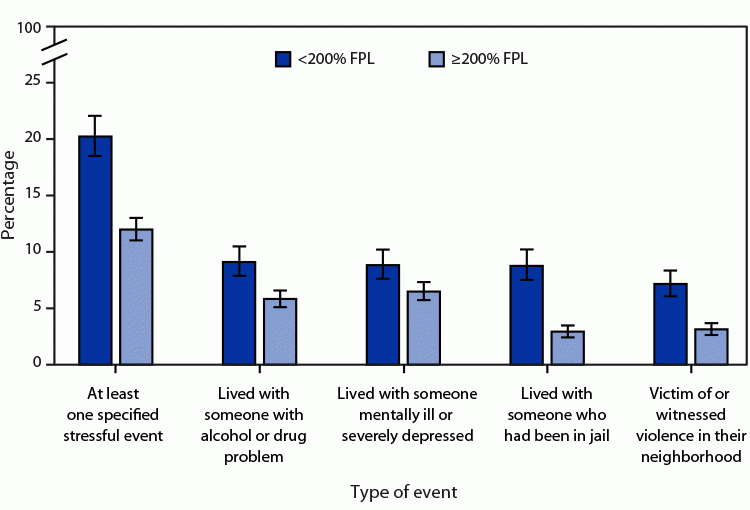
In 2021, 20.2% of children and adolescents in families with incomes <200% of FPL and 12.0% of those in families with incomes ≥200% of FPL had experienced at least one specified stressful life event. Children and adolescents in families with incomes <200% of FPL were more likely than those in families with incomes ≥200% of Read More >
Posted on byQuickStats: Number of Deaths from Hornet, Wasp, and Bee Stings Among Males and Females — National Vital Statistics System, United States, 2011–2021
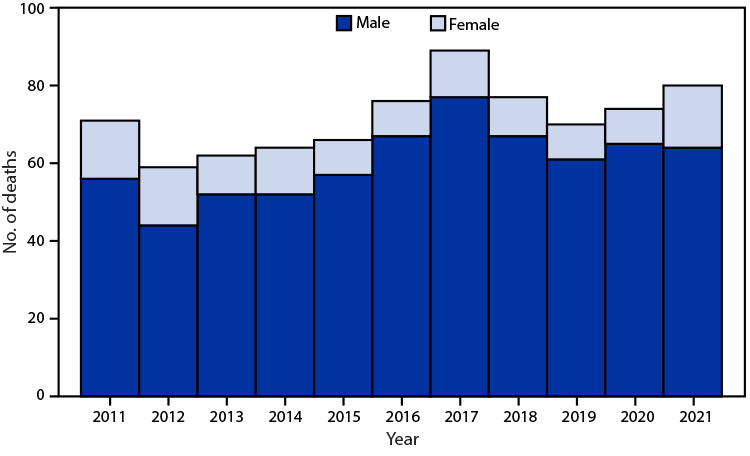
During 2011–2021, a total of 788 deaths from hornet, wasp, and bee stings occurred (an average of 72 deaths per year). The annual number of deaths ranged from 59 (2012) to 89 (2017). Overall, 84% of deaths occurred among males. Source: National Center for Health Statistics, National Vital Statistics System, Mortality Data, 2011–2021. https://wonder.cdc.gov/Deaths-by-Underlying-Cause.html Read More >
Posted on byQuickStats: Age-Adjusted Rates of Firearm-Related Homicide, by Race, Hispanic Origin, and Sex — National Vital Statistics System, United States, 2021

In 2021, among males, Black or African American (Black) males had the highest age-adjusted rate of firearm-related homicide (52.9 deaths per 100,000 standard population), and Asian males had the lowest rate (1.5). Among females, Black females had the highest rate (7.5), and Asian females had the lowest rate (0.5). Males had higher rates than females Read More >
Posted on byQuickStats: Age-Adjusted Percentage of Adults Aged 50–75 Years Who Received the Recommended Colorectal Cancer Screening, by Sex and Family Income

In 2021, 71.6% of adults aged 50–75 years reported they received the recommended colorectal cancer screening, with the percentage increasing with income from 56.7% for those with family incomes <100% of FPL to 63.0% for those with family incomes 100% to <200% of FPL, and 74.9% for those with family incomes ≥200% of FPL. The Read More >
Posted on byQuickStats: Age-Adjusted Death Rates, for Pedestrians Involved in a Collision with a Motor Vehicle, by Race and Hispanic Origin — National Vital Statistics System, United States, 2021
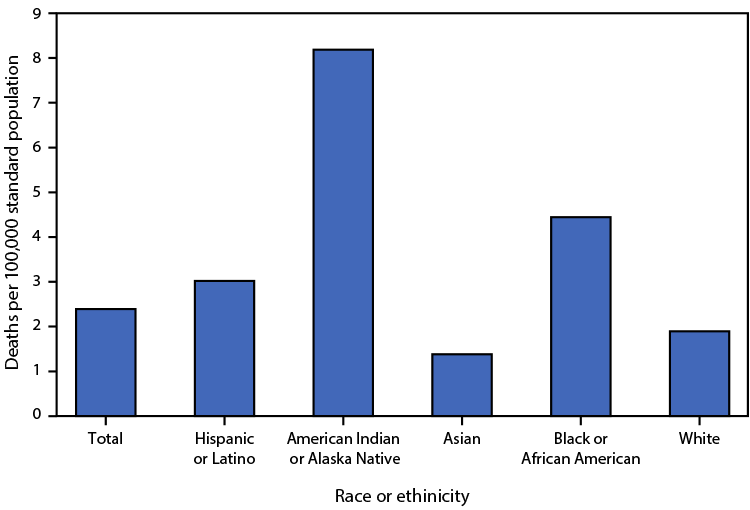
In 2021, a total of 8,392 deaths from pedestrian-involved collisions with motor vehicles occurred. The age-adjusted death rate from such collisions was highest for American Indian or Alaska Native persons (8.2 deaths per 100,000 standard population), followed by Black or African American (4.4), Hispanic or Latino (3.0), White (1.9), and Asian (1.4) persons. Source: National Vital Read More >
Posted on byQuickStats: Percentage of Adults Aged ≥18 Years Who Received Care at Home from a Friend or Family Member During the Past 12 Months, by Age Group — National Health Interview Survey
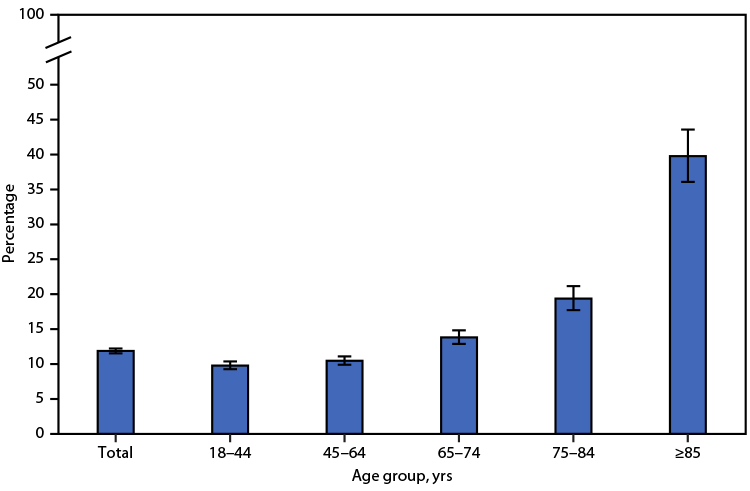
During 2021, 11.9% of adults aged ≥18 years received care at home from a friend or family member during the past 12 months. The percentage of adults who received care during the past 12 months was similar among adults aged 18–44 years (9.8%) and 45–64 years (10.5%), then increased with age to 13.8% among those Read More >
Posted on byQuickStats: Percentage of Adults Aged ≥18 Years Who Have Been Bothered a Lot by Headache or Migraine in the Past 3 Months, by Sex and Age Group — National Health Interview Survey, 2021
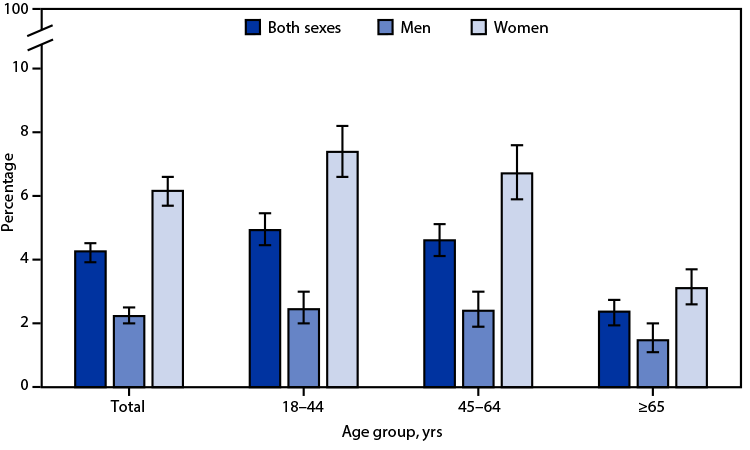
In 2021, 4.3% of adults aged ≥18 years reported being bothered a lot by headache or migraine in the past 3 months with the percentage among women (6.2%) higher than that among men (2.2%). Percentages were higher among women than men in all age groups: 7.4% versus 2.5% in adults aged 18–44 years, 6.7% versus Read More >
Posted on byQuickStats: Age-Adjusted Percentage of Adults Aged ≥18 Years Who Take Prescription Medication for Depression, by Sex and Race and Hispanic Origin — National Health Interview Survey, United States, 2021
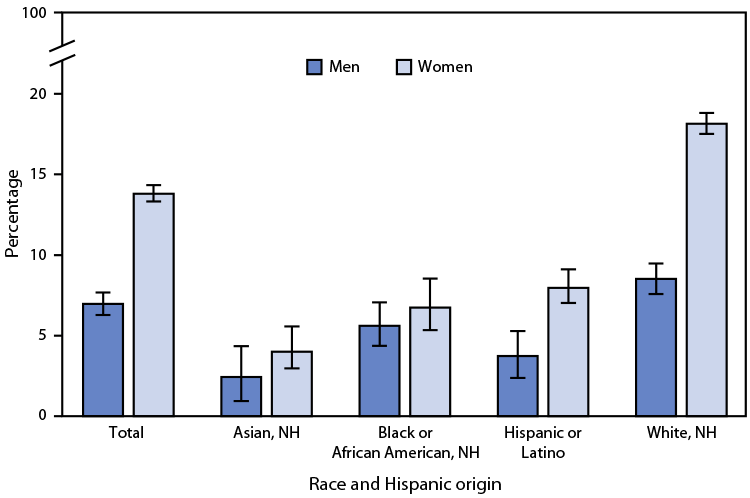
In 2021, among adults aged ≥18 years, women were more likely to take prescription medication for depression than were men (13.8% versus 7%). This pattern was found among non-Hispanic White (White) (18.1% versus 8.5%) and Hispanic or Latino (8.0% versus 3.7%) adults, but differences by sex were not statistically significant among non-Hispanic Black or African Read More >
Posted on byQuickStats: Percentage of Children and Adolescents Aged 5–17 Years Who Received Free or Reduced-Cost Meals at School During the Previous 12 Months, by Race and Hispanic Ethnicity and Family Income — National Health Interview Survey, United States, 2021

In 2021, 51.6% of all U.S. children and adolescents aged 5–17 years received free or reduced-cost meals at school during the previous 12 months; NH Black or African American (66.2%) and Hispanic or Latino (Hispanic) (64.4%) children and adolescents were more likely to receive free or reduced-cost meals at school than were NH White (42.7%) Read More >
Posted on byQuickStats: Age-Adjusted Percentage of Adults Aged ≥18 Years Who Had a Repetitive Strain Injury During the Past 3 Months, by Sex and Race and Hispanic Origin
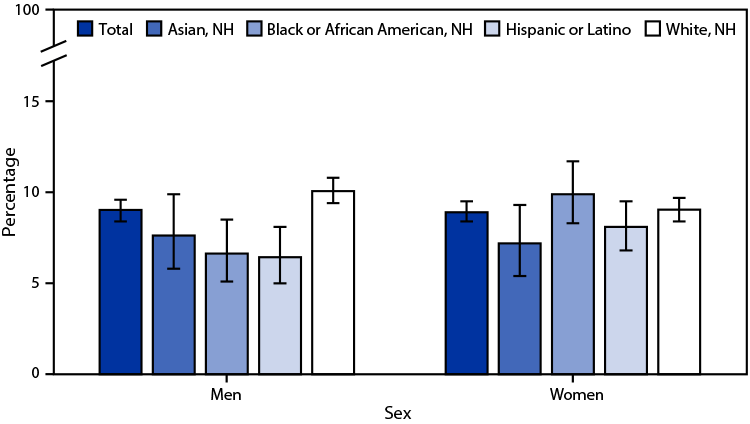
In 2021, 9.0% of men and 8.9% of women aged ≥18 years had a repetitive strain injury during the past 3 months. Non-Hispanic White men (10.1%) were more likely to have a repetitive strain injury than were non-Hispanic Asian (Asian) (7.6%), non-Hispanic Black or African American (Black) (6.6%), and Hispanic or Latino (Hispanic) (6.4%) men. Read More >
Posted on byQuickStats: Percentage of Currently Employed Adults Aged ≥18 Years Who Have Paid Sick Leave by Education Level — National Health Interview Survey, 2021
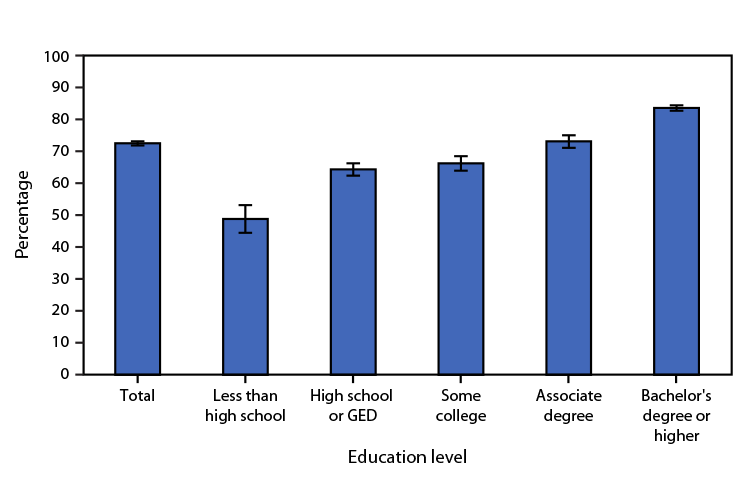
In 2021, 72.5% of employed adults had paid sick leave. The percentage with sick leave was highest among workers with a bachelor’s degree or higher (83.6%), followed by workers with an associate degree (73.2%). The percentage of sick leave was similar for workers with some college (66.3%) and those with a high school diploma or Read More >
Posted on byQuickStats: Percentage of Adults Who Were in Families Having Problems Paying Medical Bills During the Previous 12 Months, by Race and Selected Hispanic Origin Subgroups — National Health Interview Survey, United States, 2020−2021
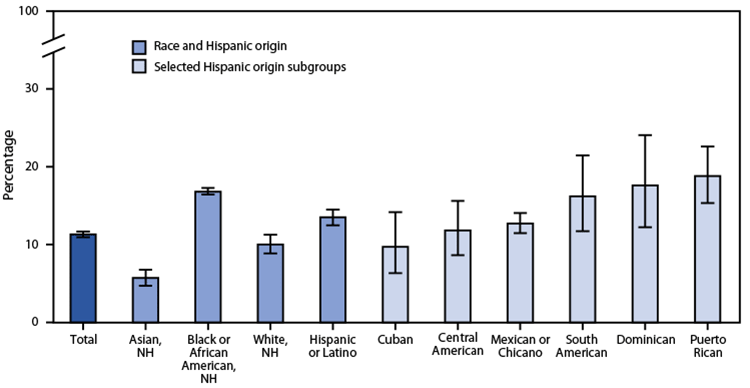
During 2020–2021, the percentage of U.S. adults who were in families having problems paying medical bills during the previous 12 months was 11.3%. Non-Hispanic Black or African American adults (16.8%) were most likely to be in families having problems paying medical bills followed by Hispanic or Latino (13.5%), non-Hispanic White (10.0%), and non-Hispanic Asian (5.7%) Read More >
Posted on byQuickStats: Age-Adjusted Percentage of Adults Aged ≥18 Years with Serious Psychological Distress During the Past 30 Days, by Family Income — National Health Interview Survey, 2021

In 2021, 3.8% of adults aged ≥18 years had serious psychological distress during the past 30 days. The age-adjusted percentage of adults who had serious psychological distress decreased with increasing family income, from 8.9% of adults with family income <100% of FPL, to 5.8% of adults with family income 100%–199% of FPL, to 3.8% of Read More >
Posted on byQuickStats: Percentage Distribution of Cigarette Smoking Status Among Current Adult E-Cigarette Users, by Age Group — National Health Interview Survey, United States, 2021
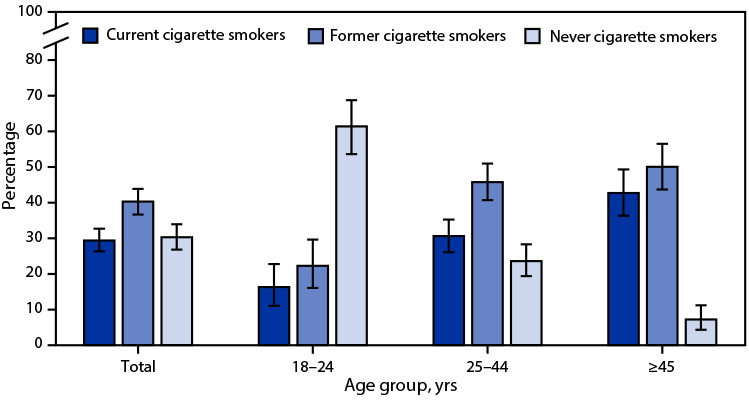
In 2021, 4.5% of U.S. adults were current e-cigarette users. Among adult e-cigarette users overall, 29.4% also were current cigarette smokers, 40.3% were former cigarette smokers, and 30.3% had never been cigarette smokers. Among e-cigarette users aged 18–24 years, 16.3% were current smokers, 22.3% were former smokers, and 61.4% had never been cigarette smokers. Among Read More >
Posted on byQuickStats: Percentage of Adults Aged ≥18 Years with Serious Psychological Distress in the Past 30 Days, by Sex and Age Group — National Health Interview Survey, United States, 2021
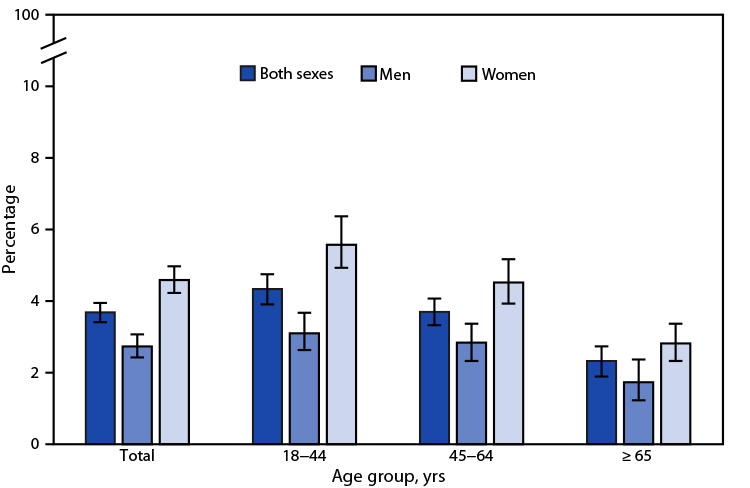
In 2021, 3.7% of adults aged ≥18 years had serious psychological distress in the past 30 days with percentages higher among women (4.6%) than among men (2.7%). The higher percentages among women were seen across all age groups: 5.6% versus 3.1% in adults aged 18–44 years, 4.5% versus 2.8% in those aged 45–64 years, and Read More >
Posted on byQuickStats: Percentage of Women Aged 50–74 Years Who Had a Mammogram Within the Preceding 2 Years by Family Income — National Health Interview Survey, United States, 2021
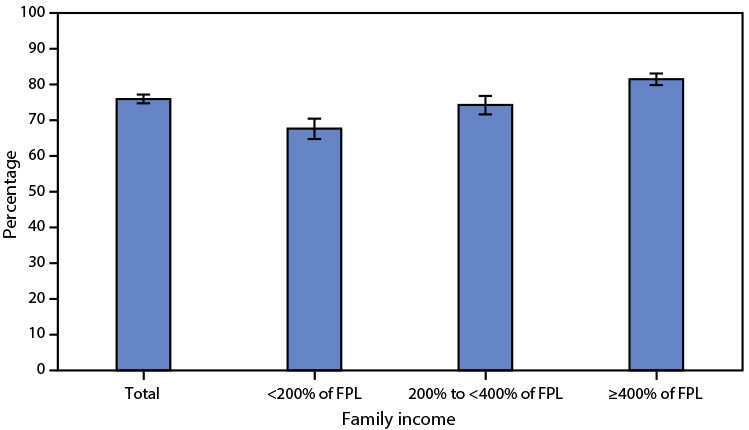
In 2021, 76.0% of women aged 50–74 years reported that they had a mammogram within the preceding 2 years. The percentage of women who had a mammogram within the preceding 2 years increased with family income, from 67.7% of women with family income <200% of federal poverty level (FPL), to 74.3% of women with income Read More >
Posted on byQuickStats: Percentage of Adults Aged ≥45 Years Who Use a Hearing Aid, by Sex and Age Group — National Health Interview Survey, United States, 2021
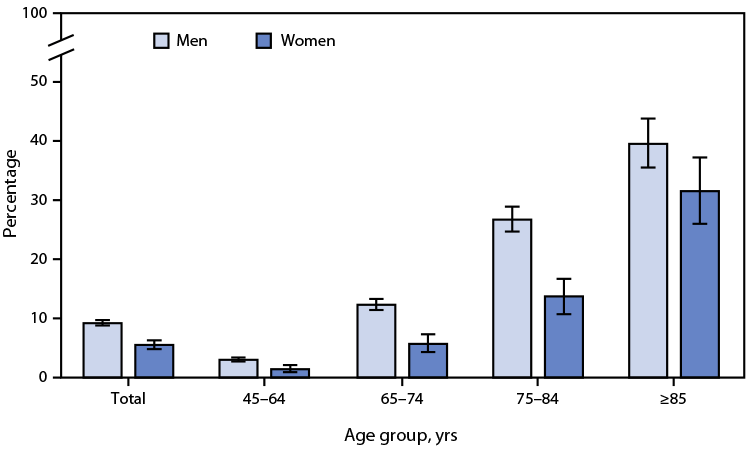
In 2021, among adults aged ≥45 years, men were more likely to use a hearing aid than were women (9.2% versus 5.5%). This pattern was found in all age groups: 3.0% of men versus 1.4% of women among those aged 45–64 years, 12.3% versus 5.7% among those aged 65–74 years, 26.7% versus 13.7% among those Read More >
Posted on byQuickStats: Percentage of Persons Who Used Telemedicine During the Past 12 Months, by Age Group — National Health Interview Survey, United States, 2021
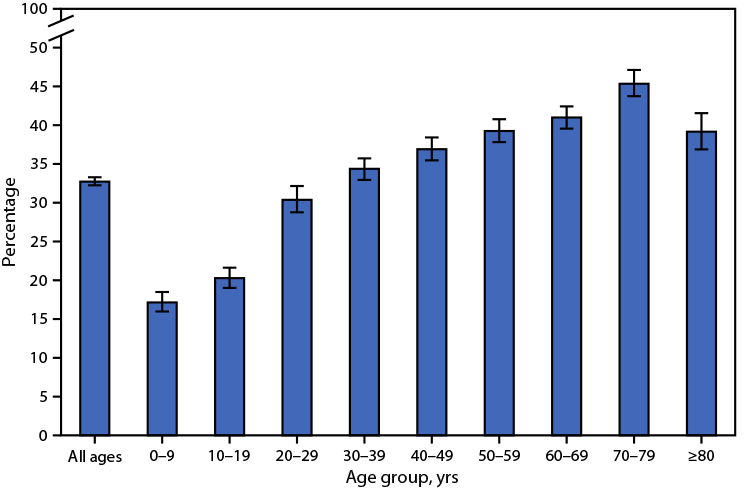
In 2021, approximately one third (32.8%) of persons of all ages had a telemedicine appointment with a doctor, nurse, or other health professional during the past 12 months. The percentage with a telemedicine appointment increased with age, from 17.2% among children aged <10 years to 45.5% among adults aged 70–79 years, and then decreased to Read More >
Posted on byQuickStats: Age-Adjusted Percentage of Adults Aged 18 Years or Older With Arthritis, by Sex and Race and Hispanic Origin — National Health Interview Survey, United States, 2021

In 2021, among adults aged 18 years or older, women were more likely to have arthritis than men (21.0% versus 16.2%). This pattern was consistent among non-Hispanic White (White) (22.2% versus 17.7%), non-Hispanic Black or African American (Black) (24.6% versus 13.9%), and Hispanic or Latino (17.7% versus 12.4%) adults. Among non-Hispanic Asian (Asian) adults, the Read More >
Posted on by
